Directors' Remuneration, Profit, and Share Price: An ASX Analysis
VerifiedAdded on 2023/06/11
|29
|6647
|355
Report
AI Summary
This report investigates the relationship between directors' remuneration and the financial performance of Australian firms listed on the ASX. It explores how executive compensation influences profitability, as measured by share price and net profit. The research uses statistical analysis, including ANOVA and correlation analysis, to assess the link between director pay and company financial outcomes, considering factors such as company mission, strategic goals, and communication with stakeholders. The study also acknowledges limitations and provides recommendations for future research, contributing to the understanding of executive compensation dynamics in the Australian corporate sector. Desklib provides access to similar solved assignments and past papers for students.
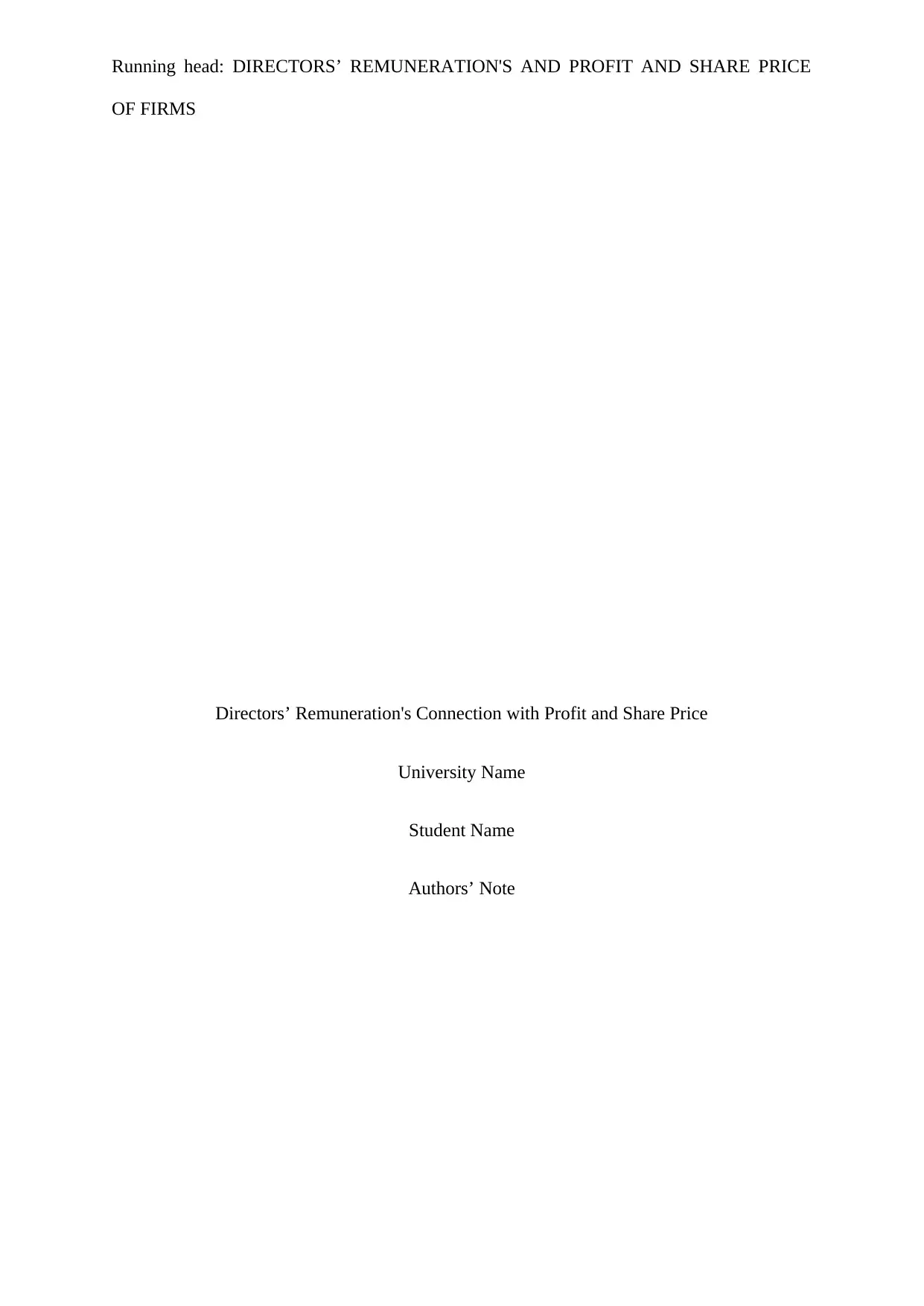
Running head: DIRECTORS’ REMUNERATION'S AND PROFIT AND SHARE PRICE
OF FIRMS
Directors’ Remuneration's Connection with Profit and Share Price
University Name
Student Name
Authors’ Note
OF FIRMS
Directors’ Remuneration's Connection with Profit and Share Price
University Name
Student Name
Authors’ Note
Paraphrase This Document
Need a fresh take? Get an instant paraphrase of this document with our AI Paraphraser
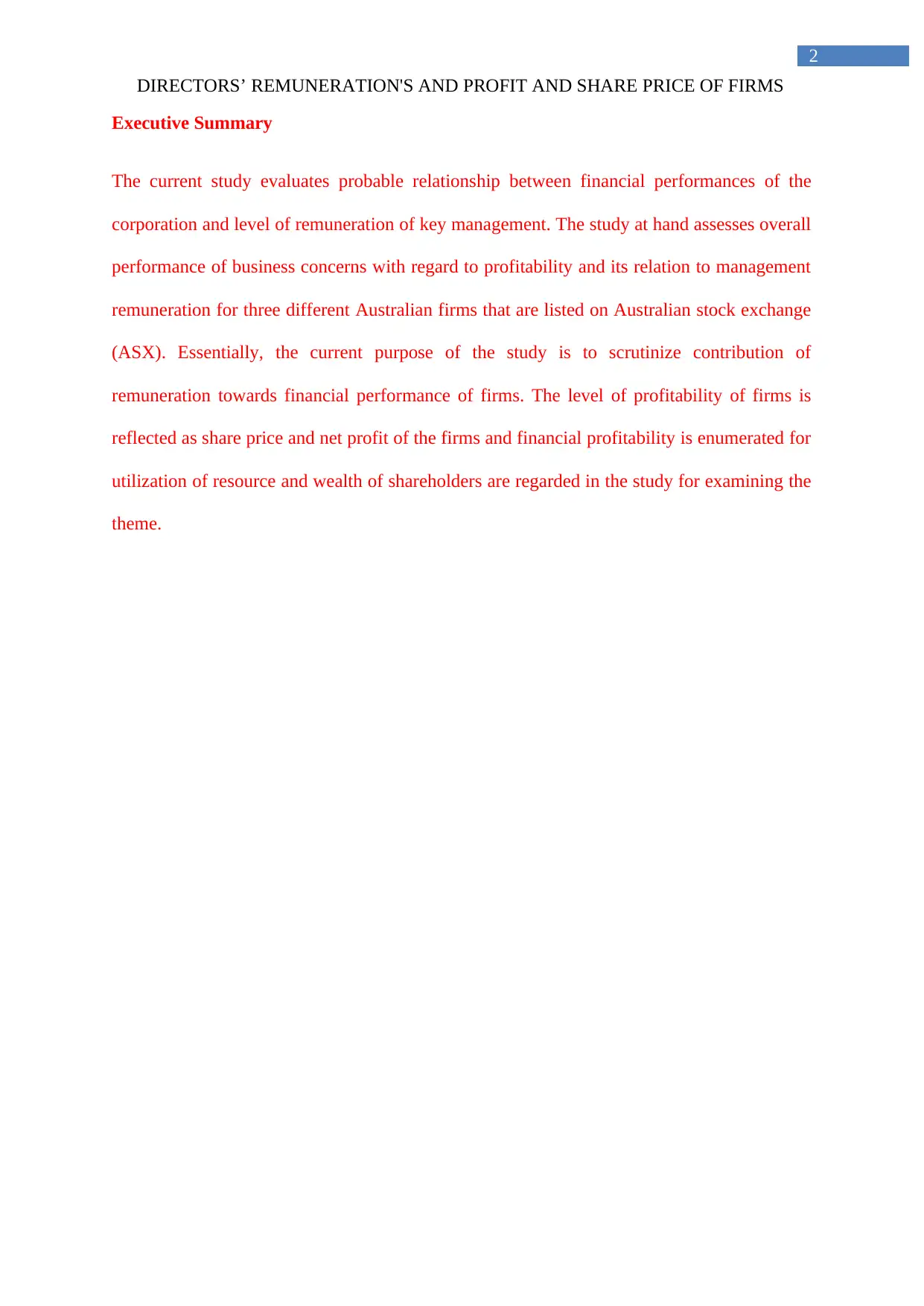
2
DIRECTORS’ REMUNERATION'S AND PROFIT AND SHARE PRICE OF FIRMS
Executive Summary
The current study evaluates probable relationship between financial performances of the
corporation and level of remuneration of key management. The study at hand assesses overall
performance of business concerns with regard to profitability and its relation to management
remuneration for three different Australian firms that are listed on Australian stock exchange
(ASX). Essentially, the current purpose of the study is to scrutinize contribution of
remuneration towards financial performance of firms. The level of profitability of firms is
reflected as share price and net profit of the firms and financial profitability is enumerated for
utilization of resource and wealth of shareholders are regarded in the study for examining the
theme.
DIRECTORS’ REMUNERATION'S AND PROFIT AND SHARE PRICE OF FIRMS
Executive Summary
The current study evaluates probable relationship between financial performances of the
corporation and level of remuneration of key management. The study at hand assesses overall
performance of business concerns with regard to profitability and its relation to management
remuneration for three different Australian firms that are listed on Australian stock exchange
(ASX). Essentially, the current purpose of the study is to scrutinize contribution of
remuneration towards financial performance of firms. The level of profitability of firms is
reflected as share price and net profit of the firms and financial profitability is enumerated for
utilization of resource and wealth of shareholders are regarded in the study for examining the
theme.
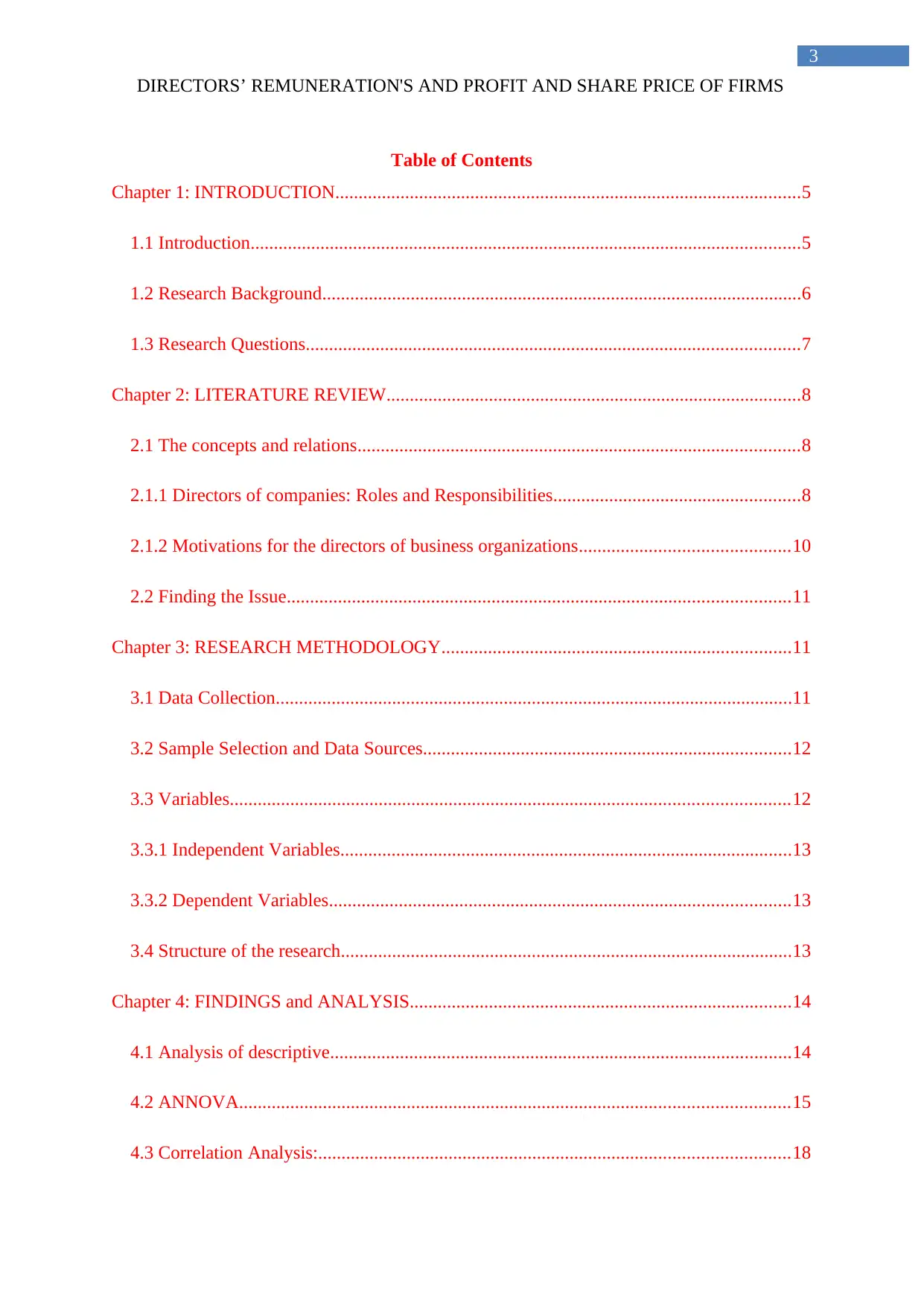
3
DIRECTORS’ REMUNERATION'S AND PROFIT AND SHARE PRICE OF FIRMS
Table of Contents
Chapter 1: INTRODUCTION....................................................................................................5
1.1 Introduction......................................................................................................................5
1.2 Research Background.......................................................................................................6
1.3 Research Questions..........................................................................................................7
Chapter 2: LITERATURE REVIEW.........................................................................................8
2.1 The concepts and relations...............................................................................................8
2.1.1 Directors of companies: Roles and Responsibilities.....................................................8
2.1.2 Motivations for the directors of business organizations.............................................10
2.2 Finding the Issue............................................................................................................11
Chapter 3: RESEARCH METHODOLOGY...........................................................................11
3.1 Data Collection...............................................................................................................11
3.2 Sample Selection and Data Sources...............................................................................12
3.3 Variables........................................................................................................................12
3.3.1 Independent Variables.................................................................................................13
3.3.2 Dependent Variables...................................................................................................13
3.4 Structure of the research.................................................................................................13
Chapter 4: FINDINGS and ANALYSIS..................................................................................14
4.1 Analysis of descriptive...................................................................................................14
4.2 ANNOVA......................................................................................................................15
4.3 Correlation Analysis:.....................................................................................................18
DIRECTORS’ REMUNERATION'S AND PROFIT AND SHARE PRICE OF FIRMS
Table of Contents
Chapter 1: INTRODUCTION....................................................................................................5
1.1 Introduction......................................................................................................................5
1.2 Research Background.......................................................................................................6
1.3 Research Questions..........................................................................................................7
Chapter 2: LITERATURE REVIEW.........................................................................................8
2.1 The concepts and relations...............................................................................................8
2.1.1 Directors of companies: Roles and Responsibilities.....................................................8
2.1.2 Motivations for the directors of business organizations.............................................10
2.2 Finding the Issue............................................................................................................11
Chapter 3: RESEARCH METHODOLOGY...........................................................................11
3.1 Data Collection...............................................................................................................11
3.2 Sample Selection and Data Sources...............................................................................12
3.3 Variables........................................................................................................................12
3.3.1 Independent Variables.................................................................................................13
3.3.2 Dependent Variables...................................................................................................13
3.4 Structure of the research.................................................................................................13
Chapter 4: FINDINGS and ANALYSIS..................................................................................14
4.1 Analysis of descriptive...................................................................................................14
4.2 ANNOVA......................................................................................................................15
4.3 Correlation Analysis:.....................................................................................................18
⊘ This is a preview!⊘
Do you want full access?
Subscribe today to unlock all pages.

Trusted by 1+ million students worldwide

4
DIRECTORS’ REMUNERATION'S AND PROFIT AND SHARE PRICE OF FIRMS
Chapter 5: DISCUSSION.......................................................................................................20
5.1 Directors remuneration with the profit..........................................................................20
5.2 Limitations.....................................................................................................................20
5.3 Conclusion and Recommendations................................................................................21
References................................................................................................................................22
Appendix:.................................................................................................................................26
1) Raw Data..........................................................................................................................26
2) Descriptive.......................................................................................................................26
3) ANNOVA........................................................................................................................27
3) Enumeration of Correlation.............................................................................................29
DIRECTORS’ REMUNERATION'S AND PROFIT AND SHARE PRICE OF FIRMS
Chapter 5: DISCUSSION.......................................................................................................20
5.1 Directors remuneration with the profit..........................................................................20
5.2 Limitations.....................................................................................................................20
5.3 Conclusion and Recommendations................................................................................21
References................................................................................................................................22
Appendix:.................................................................................................................................26
1) Raw Data..........................................................................................................................26
2) Descriptive.......................................................................................................................26
3) ANNOVA........................................................................................................................27
3) Enumeration of Correlation.............................................................................................29
Paraphrase This Document
Need a fresh take? Get an instant paraphrase of this document with our AI Paraphraser
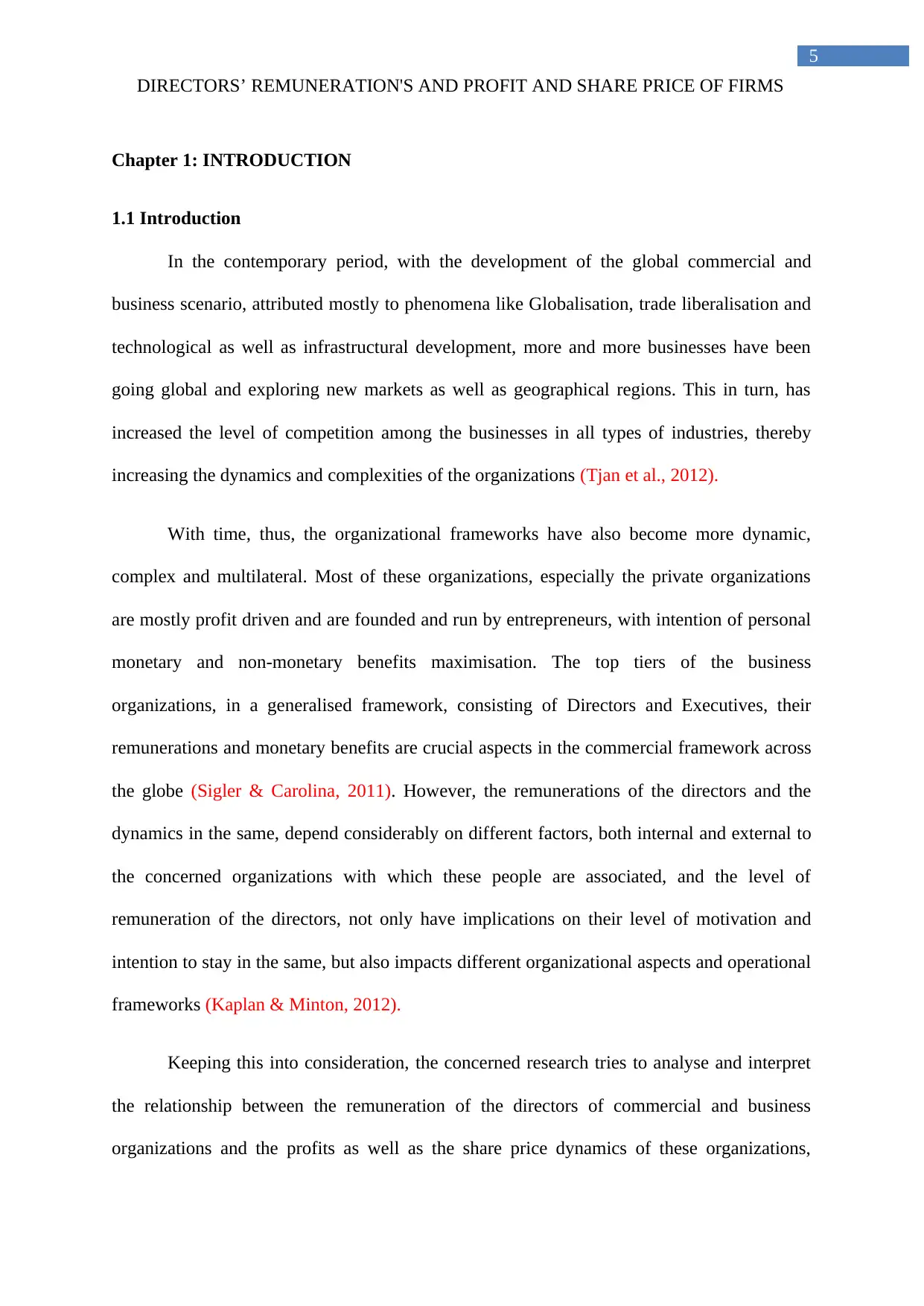
5
DIRECTORS’ REMUNERATION'S AND PROFIT AND SHARE PRICE OF FIRMS
Chapter 1: INTRODUCTION
1.1 Introduction
In the contemporary period, with the development of the global commercial and
business scenario, attributed mostly to phenomena like Globalisation, trade liberalisation and
technological as well as infrastructural development, more and more businesses have been
going global and exploring new markets as well as geographical regions. This in turn, has
increased the level of competition among the businesses in all types of industries, thereby
increasing the dynamics and complexities of the organizations (Tjan et al., 2012).
With time, thus, the organizational frameworks have also become more dynamic,
complex and multilateral. Most of these organizations, especially the private organizations
are mostly profit driven and are founded and run by entrepreneurs, with intention of personal
monetary and non-monetary benefits maximisation. The top tiers of the business
organizations, in a generalised framework, consisting of Directors and Executives, their
remunerations and monetary benefits are crucial aspects in the commercial framework across
the globe (Sigler & Carolina, 2011). However, the remunerations of the directors and the
dynamics in the same, depend considerably on different factors, both internal and external to
the concerned organizations with which these people are associated, and the level of
remuneration of the directors, not only have implications on their level of motivation and
intention to stay in the same, but also impacts different organizational aspects and operational
frameworks (Kaplan & Minton, 2012).
Keeping this into consideration, the concerned research tries to analyse and interpret
the relationship between the remuneration of the directors of commercial and business
organizations and the profits as well as the share price dynamics of these organizations,
DIRECTORS’ REMUNERATION'S AND PROFIT AND SHARE PRICE OF FIRMS
Chapter 1: INTRODUCTION
1.1 Introduction
In the contemporary period, with the development of the global commercial and
business scenario, attributed mostly to phenomena like Globalisation, trade liberalisation and
technological as well as infrastructural development, more and more businesses have been
going global and exploring new markets as well as geographical regions. This in turn, has
increased the level of competition among the businesses in all types of industries, thereby
increasing the dynamics and complexities of the organizations (Tjan et al., 2012).
With time, thus, the organizational frameworks have also become more dynamic,
complex and multilateral. Most of these organizations, especially the private organizations
are mostly profit driven and are founded and run by entrepreneurs, with intention of personal
monetary and non-monetary benefits maximisation. The top tiers of the business
organizations, in a generalised framework, consisting of Directors and Executives, their
remunerations and monetary benefits are crucial aspects in the commercial framework across
the globe (Sigler & Carolina, 2011). However, the remunerations of the directors and the
dynamics in the same, depend considerably on different factors, both internal and external to
the concerned organizations with which these people are associated, and the level of
remuneration of the directors, not only have implications on their level of motivation and
intention to stay in the same, but also impacts different organizational aspects and operational
frameworks (Kaplan & Minton, 2012).
Keeping this into consideration, the concerned research tries to analyse and interpret
the relationship between the remuneration of the directors of commercial and business
organizations and the profits as well as the share price dynamics of these organizations,
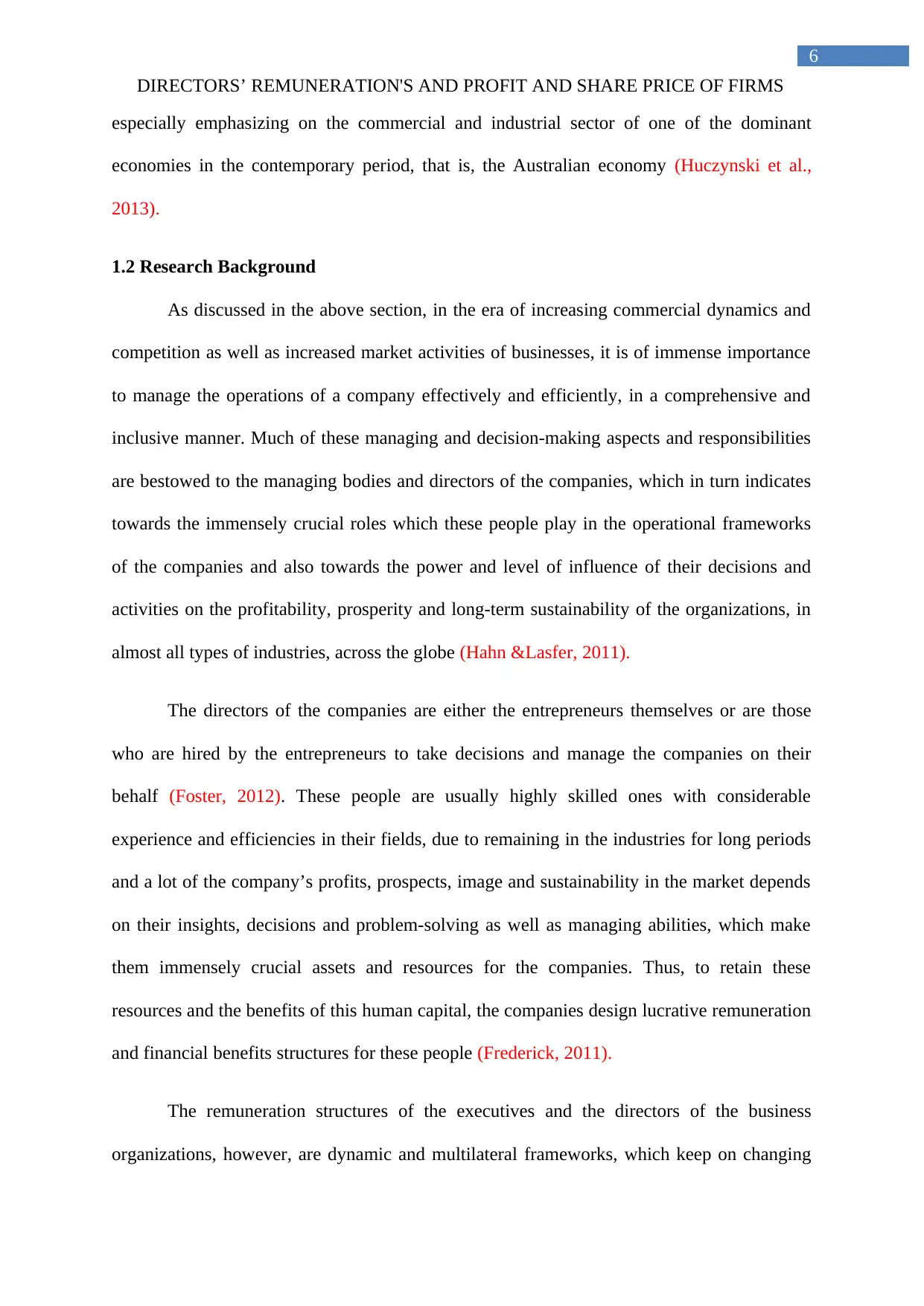
6
DIRECTORS’ REMUNERATION'S AND PROFIT AND SHARE PRICE OF FIRMS
especially emphasizing on the commercial and industrial sector of one of the dominant
economies in the contemporary period, that is, the Australian economy (Huczynski et al.,
2013).
1.2 Research Background
As discussed in the above section, in the era of increasing commercial dynamics and
competition as well as increased market activities of businesses, it is of immense importance
to manage the operations of a company effectively and efficiently, in a comprehensive and
inclusive manner. Much of these managing and decision-making aspects and responsibilities
are bestowed to the managing bodies and directors of the companies, which in turn indicates
towards the immensely crucial roles which these people play in the operational frameworks
of the companies and also towards the power and level of influence of their decisions and
activities on the profitability, prosperity and long-term sustainability of the organizations, in
almost all types of industries, across the globe (Hahn &Lasfer, 2011).
The directors of the companies are either the entrepreneurs themselves or are those
who are hired by the entrepreneurs to take decisions and manage the companies on their
behalf (Foster, 2012). These people are usually highly skilled ones with considerable
experience and efficiencies in their fields, due to remaining in the industries for long periods
and a lot of the company’s profits, prospects, image and sustainability in the market depends
on their insights, decisions and problem-solving as well as managing abilities, which make
them immensely crucial assets and resources for the companies. Thus, to retain these
resources and the benefits of this human capital, the companies design lucrative remuneration
and financial benefits structures for these people (Frederick, 2011).
The remuneration structures of the executives and the directors of the business
organizations, however, are dynamic and multilateral frameworks, which keep on changing
DIRECTORS’ REMUNERATION'S AND PROFIT AND SHARE PRICE OF FIRMS
especially emphasizing on the commercial and industrial sector of one of the dominant
economies in the contemporary period, that is, the Australian economy (Huczynski et al.,
2013).
1.2 Research Background
As discussed in the above section, in the era of increasing commercial dynamics and
competition as well as increased market activities of businesses, it is of immense importance
to manage the operations of a company effectively and efficiently, in a comprehensive and
inclusive manner. Much of these managing and decision-making aspects and responsibilities
are bestowed to the managing bodies and directors of the companies, which in turn indicates
towards the immensely crucial roles which these people play in the operational frameworks
of the companies and also towards the power and level of influence of their decisions and
activities on the profitability, prosperity and long-term sustainability of the organizations, in
almost all types of industries, across the globe (Hahn &Lasfer, 2011).
The directors of the companies are either the entrepreneurs themselves or are those
who are hired by the entrepreneurs to take decisions and manage the companies on their
behalf (Foster, 2012). These people are usually highly skilled ones with considerable
experience and efficiencies in their fields, due to remaining in the industries for long periods
and a lot of the company’s profits, prospects, image and sustainability in the market depends
on their insights, decisions and problem-solving as well as managing abilities, which make
them immensely crucial assets and resources for the companies. Thus, to retain these
resources and the benefits of this human capital, the companies design lucrative remuneration
and financial benefits structures for these people (Frederick, 2011).
The remuneration structures of the executives and the directors of the business
organizations, however, are dynamic and multilateral frameworks, which keep on changing
⊘ This is a preview!⊘
Do you want full access?
Subscribe today to unlock all pages.

Trusted by 1+ million students worldwide
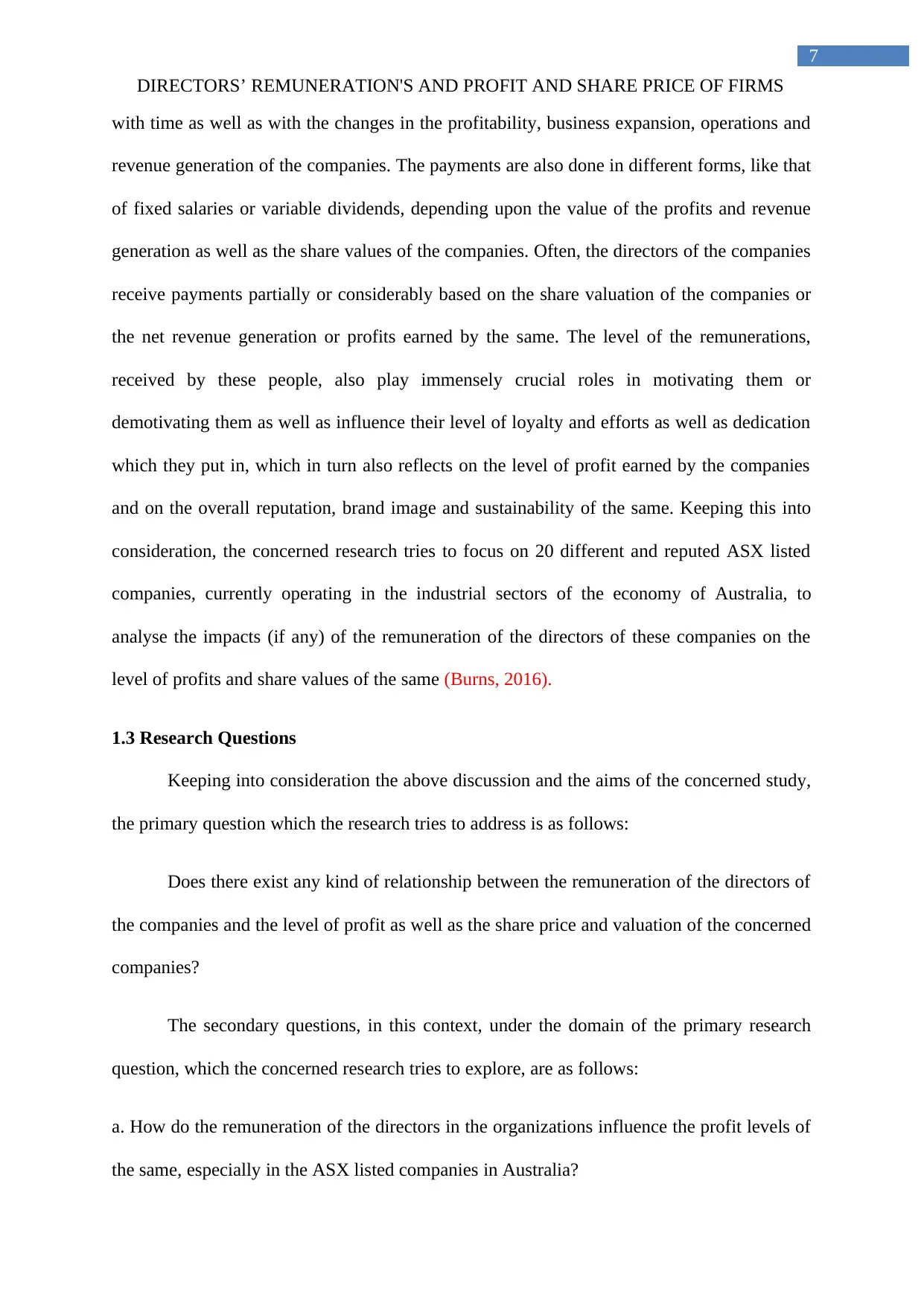
7
DIRECTORS’ REMUNERATION'S AND PROFIT AND SHARE PRICE OF FIRMS
with time as well as with the changes in the profitability, business expansion, operations and
revenue generation of the companies. The payments are also done in different forms, like that
of fixed salaries or variable dividends, depending upon the value of the profits and revenue
generation as well as the share values of the companies. Often, the directors of the companies
receive payments partially or considerably based on the share valuation of the companies or
the net revenue generation or profits earned by the same. The level of the remunerations,
received by these people, also play immensely crucial roles in motivating them or
demotivating them as well as influence their level of loyalty and efforts as well as dedication
which they put in, which in turn also reflects on the level of profit earned by the companies
and on the overall reputation, brand image and sustainability of the same. Keeping this into
consideration, the concerned research tries to focus on 20 different and reputed ASX listed
companies, currently operating in the industrial sectors of the economy of Australia, to
analyse the impacts (if any) of the remuneration of the directors of these companies on the
level of profits and share values of the same (Burns, 2016).
1.3 Research Questions
Keeping into consideration the above discussion and the aims of the concerned study,
the primary question which the research tries to address is as follows:
Does there exist any kind of relationship between the remuneration of the directors of
the companies and the level of profit as well as the share price and valuation of the concerned
companies?
The secondary questions, in this context, under the domain of the primary research
question, which the concerned research tries to explore, are as follows:
a. How do the remuneration of the directors in the organizations influence the profit levels of
the same, especially in the ASX listed companies in Australia?
DIRECTORS’ REMUNERATION'S AND PROFIT AND SHARE PRICE OF FIRMS
with time as well as with the changes in the profitability, business expansion, operations and
revenue generation of the companies. The payments are also done in different forms, like that
of fixed salaries or variable dividends, depending upon the value of the profits and revenue
generation as well as the share values of the companies. Often, the directors of the companies
receive payments partially or considerably based on the share valuation of the companies or
the net revenue generation or profits earned by the same. The level of the remunerations,
received by these people, also play immensely crucial roles in motivating them or
demotivating them as well as influence their level of loyalty and efforts as well as dedication
which they put in, which in turn also reflects on the level of profit earned by the companies
and on the overall reputation, brand image and sustainability of the same. Keeping this into
consideration, the concerned research tries to focus on 20 different and reputed ASX listed
companies, currently operating in the industrial sectors of the economy of Australia, to
analyse the impacts (if any) of the remuneration of the directors of these companies on the
level of profits and share values of the same (Burns, 2016).
1.3 Research Questions
Keeping into consideration the above discussion and the aims of the concerned study,
the primary question which the research tries to address is as follows:
Does there exist any kind of relationship between the remuneration of the directors of
the companies and the level of profit as well as the share price and valuation of the concerned
companies?
The secondary questions, in this context, under the domain of the primary research
question, which the concerned research tries to explore, are as follows:
a. How do the remuneration of the directors in the organizations influence the profit levels of
the same, especially in the ASX listed companies in Australia?
Paraphrase This Document
Need a fresh take? Get an instant paraphrase of this document with our AI Paraphraser
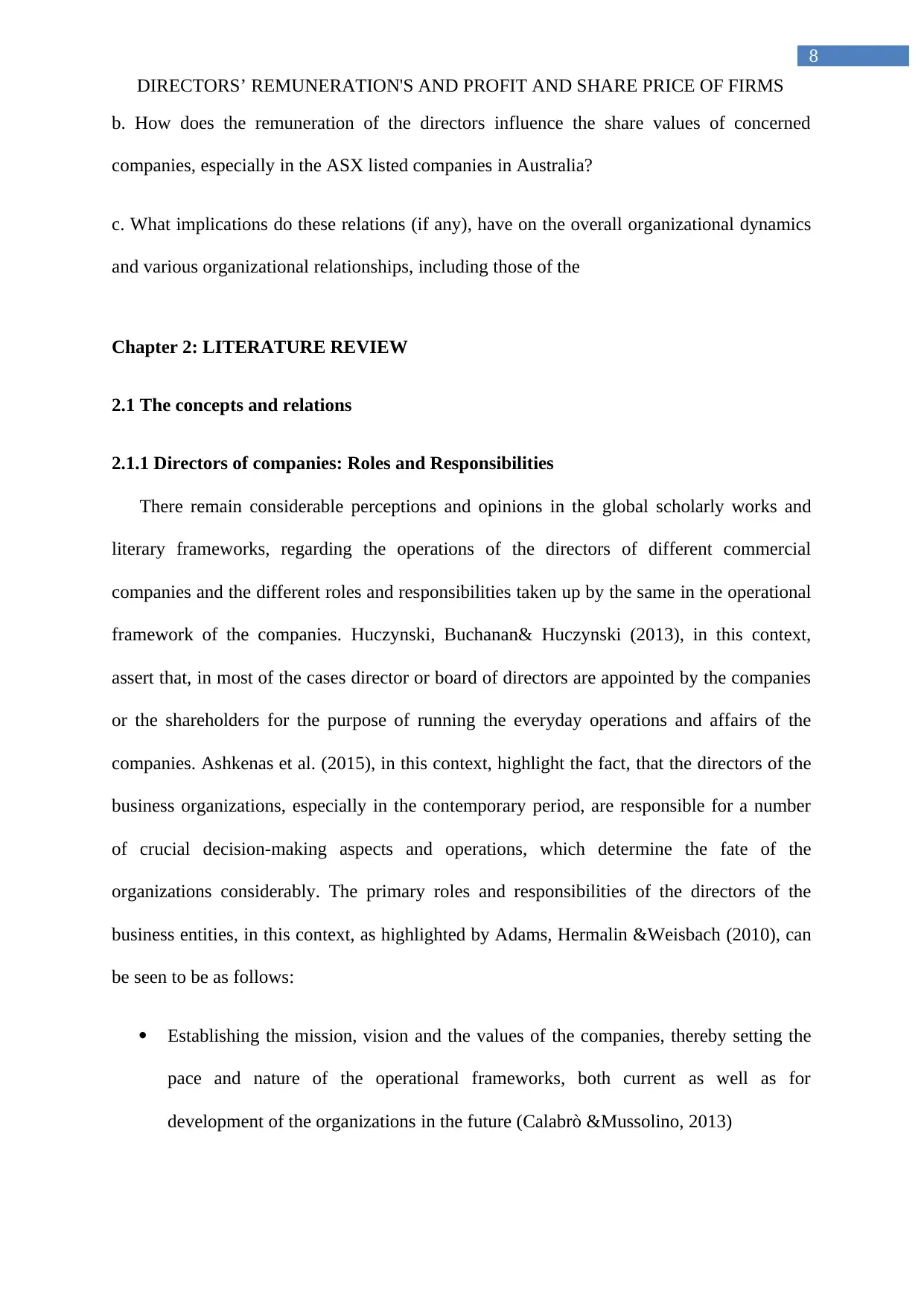
8
DIRECTORS’ REMUNERATION'S AND PROFIT AND SHARE PRICE OF FIRMS
b. How does the remuneration of the directors influence the share values of concerned
companies, especially in the ASX listed companies in Australia?
c. What implications do these relations (if any), have on the overall organizational dynamics
and various organizational relationships, including those of the
Chapter 2: LITERATURE REVIEW
2.1 The concepts and relations
2.1.1 Directors of companies: Roles and Responsibilities
There remain considerable perceptions and opinions in the global scholarly works and
literary frameworks, regarding the operations of the directors of different commercial
companies and the different roles and responsibilities taken up by the same in the operational
framework of the companies. Huczynski, Buchanan& Huczynski (2013), in this context,
assert that, in most of the cases director or board of directors are appointed by the companies
or the shareholders for the purpose of running the everyday operations and affairs of the
companies. Ashkenas et al. (2015), in this context, highlight the fact, that the directors of the
business organizations, especially in the contemporary period, are responsible for a number
of crucial decision-making aspects and operations, which determine the fate of the
organizations considerably. The primary roles and responsibilities of the directors of the
business entities, in this context, as highlighted by Adams, Hermalin &Weisbach (2010), can
be seen to be as follows:
Establishing the mission, vision and the values of the companies, thereby setting the
pace and nature of the operational frameworks, both current as well as for
development of the organizations in the future (Calabrò &Mussolino, 2013)
DIRECTORS’ REMUNERATION'S AND PROFIT AND SHARE PRICE OF FIRMS
b. How does the remuneration of the directors influence the share values of concerned
companies, especially in the ASX listed companies in Australia?
c. What implications do these relations (if any), have on the overall organizational dynamics
and various organizational relationships, including those of the
Chapter 2: LITERATURE REVIEW
2.1 The concepts and relations
2.1.1 Directors of companies: Roles and Responsibilities
There remain considerable perceptions and opinions in the global scholarly works and
literary frameworks, regarding the operations of the directors of different commercial
companies and the different roles and responsibilities taken up by the same in the operational
framework of the companies. Huczynski, Buchanan& Huczynski (2013), in this context,
assert that, in most of the cases director or board of directors are appointed by the companies
or the shareholders for the purpose of running the everyday operations and affairs of the
companies. Ashkenas et al. (2015), in this context, highlight the fact, that the directors of the
business organizations, especially in the contemporary period, are responsible for a number
of crucial decision-making aspects and operations, which determine the fate of the
organizations considerably. The primary roles and responsibilities of the directors of the
business entities, in this context, as highlighted by Adams, Hermalin &Weisbach (2010), can
be seen to be as follows:
Establishing the mission, vision and the values of the companies, thereby setting the
pace and nature of the operational frameworks, both current as well as for
development of the organizations in the future (Calabrò &Mussolino, 2013)
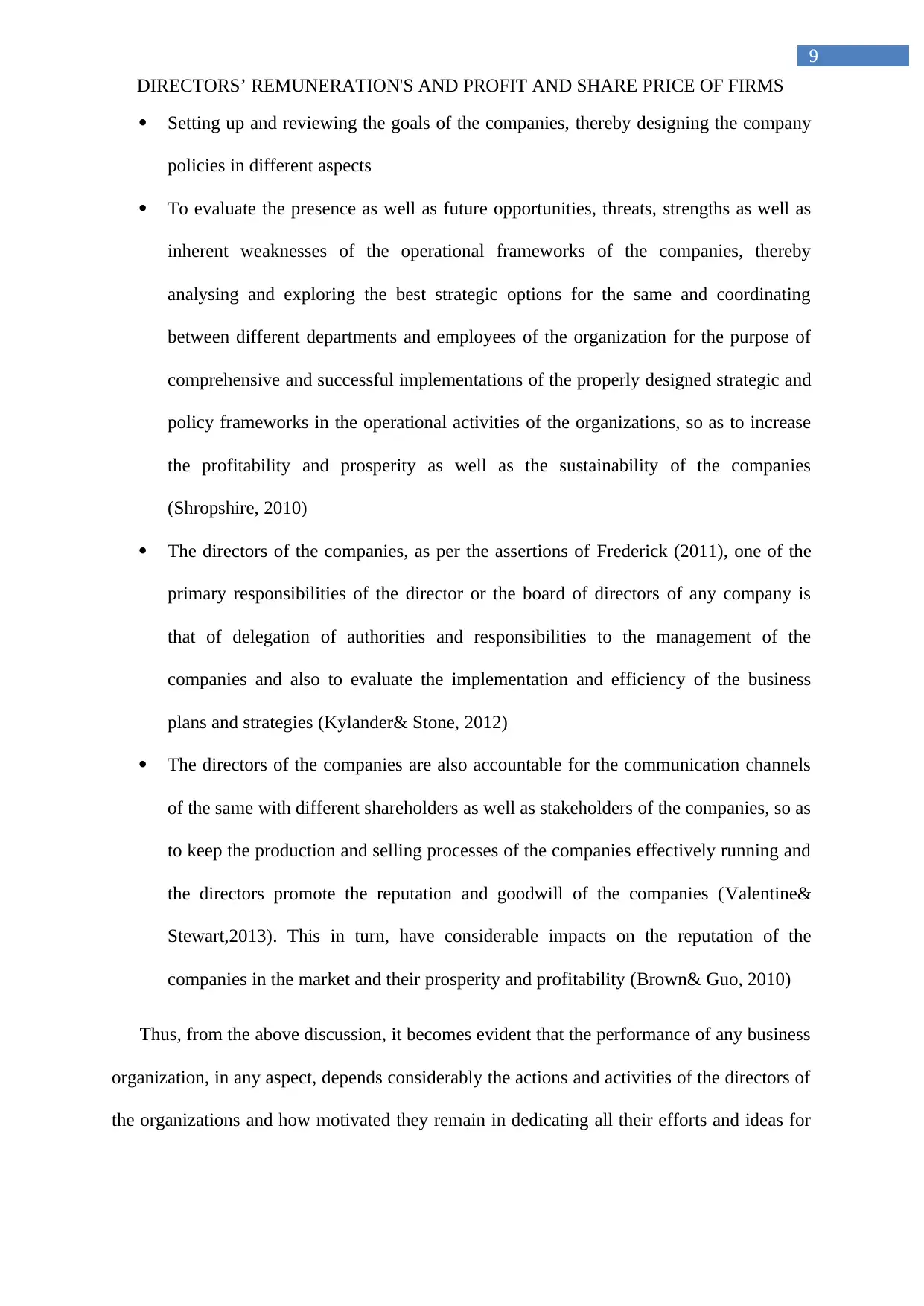
9
DIRECTORS’ REMUNERATION'S AND PROFIT AND SHARE PRICE OF FIRMS
Setting up and reviewing the goals of the companies, thereby designing the company
policies in different aspects
To evaluate the presence as well as future opportunities, threats, strengths as well as
inherent weaknesses of the operational frameworks of the companies, thereby
analysing and exploring the best strategic options for the same and coordinating
between different departments and employees of the organization for the purpose of
comprehensive and successful implementations of the properly designed strategic and
policy frameworks in the operational activities of the organizations, so as to increase
the profitability and prosperity as well as the sustainability of the companies
(Shropshire, 2010)
The directors of the companies, as per the assertions of Frederick (2011), one of the
primary responsibilities of the director or the board of directors of any company is
that of delegation of authorities and responsibilities to the management of the
companies and also to evaluate the implementation and efficiency of the business
plans and strategies (Kylander& Stone, 2012)
The directors of the companies are also accountable for the communication channels
of the same with different shareholders as well as stakeholders of the companies, so as
to keep the production and selling processes of the companies effectively running and
the directors promote the reputation and goodwill of the companies (Valentine&
Stewart,2013). This in turn, have considerable impacts on the reputation of the
companies in the market and their prosperity and profitability (Brown& Guo, 2010)
Thus, from the above discussion, it becomes evident that the performance of any business
organization, in any aspect, depends considerably the actions and activities of the directors of
the organizations and how motivated they remain in dedicating all their efforts and ideas for
DIRECTORS’ REMUNERATION'S AND PROFIT AND SHARE PRICE OF FIRMS
Setting up and reviewing the goals of the companies, thereby designing the company
policies in different aspects
To evaluate the presence as well as future opportunities, threats, strengths as well as
inherent weaknesses of the operational frameworks of the companies, thereby
analysing and exploring the best strategic options for the same and coordinating
between different departments and employees of the organization for the purpose of
comprehensive and successful implementations of the properly designed strategic and
policy frameworks in the operational activities of the organizations, so as to increase
the profitability and prosperity as well as the sustainability of the companies
(Shropshire, 2010)
The directors of the companies, as per the assertions of Frederick (2011), one of the
primary responsibilities of the director or the board of directors of any company is
that of delegation of authorities and responsibilities to the management of the
companies and also to evaluate the implementation and efficiency of the business
plans and strategies (Kylander& Stone, 2012)
The directors of the companies are also accountable for the communication channels
of the same with different shareholders as well as stakeholders of the companies, so as
to keep the production and selling processes of the companies effectively running and
the directors promote the reputation and goodwill of the companies (Valentine&
Stewart,2013). This in turn, have considerable impacts on the reputation of the
companies in the market and their prosperity and profitability (Brown& Guo, 2010)
Thus, from the above discussion, it becomes evident that the performance of any business
organization, in any aspect, depends considerably the actions and activities of the directors of
the organizations and how motivated they remain in dedicating all their efforts and ideas for
⊘ This is a preview!⊘
Do you want full access?
Subscribe today to unlock all pages.

Trusted by 1+ million students worldwide
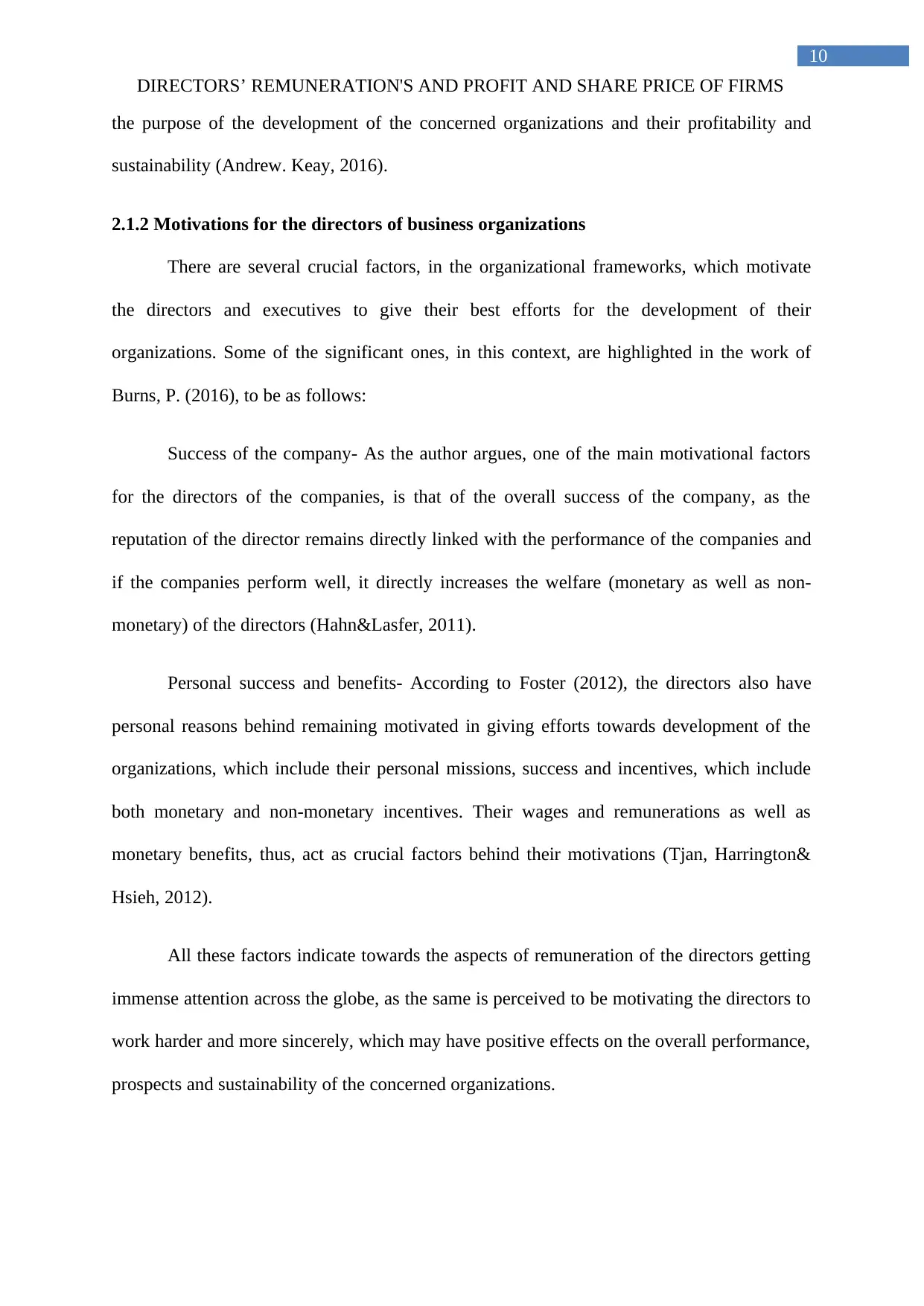
10
DIRECTORS’ REMUNERATION'S AND PROFIT AND SHARE PRICE OF FIRMS
the purpose of the development of the concerned organizations and their profitability and
sustainability (Andrew. Keay, 2016).
2.1.2 Motivations for the directors of business organizations
There are several crucial factors, in the organizational frameworks, which motivate
the directors and executives to give their best efforts for the development of their
organizations. Some of the significant ones, in this context, are highlighted in the work of
Burns, P. (2016), to be as follows:
Success of the company- As the author argues, one of the main motivational factors
for the directors of the companies, is that of the overall success of the company, as the
reputation of the director remains directly linked with the performance of the companies and
if the companies perform well, it directly increases the welfare (monetary as well as non-
monetary) of the directors (Hahn&Lasfer, 2011).
Personal success and benefits- According to Foster (2012), the directors also have
personal reasons behind remaining motivated in giving efforts towards development of the
organizations, which include their personal missions, success and incentives, which include
both monetary and non-monetary incentives. Their wages and remunerations as well as
monetary benefits, thus, act as crucial factors behind their motivations (Tjan, Harrington&
Hsieh, 2012).
All these factors indicate towards the aspects of remuneration of the directors getting
immense attention across the globe, as the same is perceived to be motivating the directors to
work harder and more sincerely, which may have positive effects on the overall performance,
prospects and sustainability of the concerned organizations.
DIRECTORS’ REMUNERATION'S AND PROFIT AND SHARE PRICE OF FIRMS
the purpose of the development of the concerned organizations and their profitability and
sustainability (Andrew. Keay, 2016).
2.1.2 Motivations for the directors of business organizations
There are several crucial factors, in the organizational frameworks, which motivate
the directors and executives to give their best efforts for the development of their
organizations. Some of the significant ones, in this context, are highlighted in the work of
Burns, P. (2016), to be as follows:
Success of the company- As the author argues, one of the main motivational factors
for the directors of the companies, is that of the overall success of the company, as the
reputation of the director remains directly linked with the performance of the companies and
if the companies perform well, it directly increases the welfare (monetary as well as non-
monetary) of the directors (Hahn&Lasfer, 2011).
Personal success and benefits- According to Foster (2012), the directors also have
personal reasons behind remaining motivated in giving efforts towards development of the
organizations, which include their personal missions, success and incentives, which include
both monetary and non-monetary incentives. Their wages and remunerations as well as
monetary benefits, thus, act as crucial factors behind their motivations (Tjan, Harrington&
Hsieh, 2012).
All these factors indicate towards the aspects of remuneration of the directors getting
immense attention across the globe, as the same is perceived to be motivating the directors to
work harder and more sincerely, which may have positive effects on the overall performance,
prospects and sustainability of the concerned organizations.
Paraphrase This Document
Need a fresh take? Get an instant paraphrase of this document with our AI Paraphraser
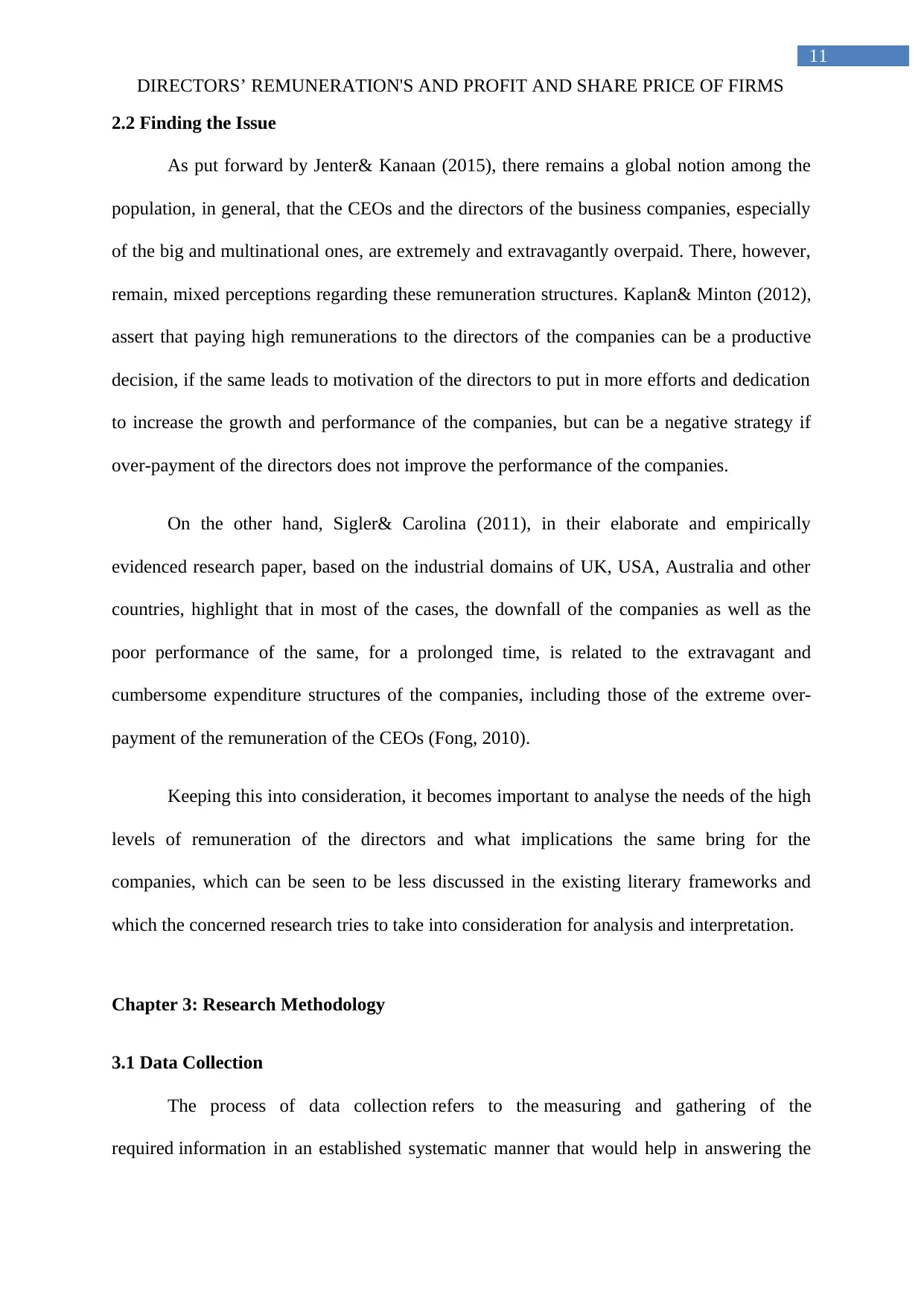
11
DIRECTORS’ REMUNERATION'S AND PROFIT AND SHARE PRICE OF FIRMS
2.2 Finding the Issue
As put forward by Jenter& Kanaan (2015), there remains a global notion among the
population, in general, that the CEOs and the directors of the business companies, especially
of the big and multinational ones, are extremely and extravagantly overpaid. There, however,
remain, mixed perceptions regarding these remuneration structures. Kaplan& Minton (2012),
assert that paying high remunerations to the directors of the companies can be a productive
decision, if the same leads to motivation of the directors to put in more efforts and dedication
to increase the growth and performance of the companies, but can be a negative strategy if
over-payment of the directors does not improve the performance of the companies.
On the other hand, Sigler& Carolina (2011), in their elaborate and empirically
evidenced research paper, based on the industrial domains of UK, USA, Australia and other
countries, highlight that in most of the cases, the downfall of the companies as well as the
poor performance of the same, for a prolonged time, is related to the extravagant and
cumbersome expenditure structures of the companies, including those of the extreme over-
payment of the remuneration of the CEOs (Fong, 2010).
Keeping this into consideration, it becomes important to analyse the needs of the high
levels of remuneration of the directors and what implications the same bring for the
companies, which can be seen to be less discussed in the existing literary frameworks and
which the concerned research tries to take into consideration for analysis and interpretation.
Chapter 3: Research Methodology
3.1 Data Collection
The process of data collection refers to the measuring and gathering of the
required information in an established systematic manner that would help in answering the
DIRECTORS’ REMUNERATION'S AND PROFIT AND SHARE PRICE OF FIRMS
2.2 Finding the Issue
As put forward by Jenter& Kanaan (2015), there remains a global notion among the
population, in general, that the CEOs and the directors of the business companies, especially
of the big and multinational ones, are extremely and extravagantly overpaid. There, however,
remain, mixed perceptions regarding these remuneration structures. Kaplan& Minton (2012),
assert that paying high remunerations to the directors of the companies can be a productive
decision, if the same leads to motivation of the directors to put in more efforts and dedication
to increase the growth and performance of the companies, but can be a negative strategy if
over-payment of the directors does not improve the performance of the companies.
On the other hand, Sigler& Carolina (2011), in their elaborate and empirically
evidenced research paper, based on the industrial domains of UK, USA, Australia and other
countries, highlight that in most of the cases, the downfall of the companies as well as the
poor performance of the same, for a prolonged time, is related to the extravagant and
cumbersome expenditure structures of the companies, including those of the extreme over-
payment of the remuneration of the CEOs (Fong, 2010).
Keeping this into consideration, it becomes important to analyse the needs of the high
levels of remuneration of the directors and what implications the same bring for the
companies, which can be seen to be less discussed in the existing literary frameworks and
which the concerned research tries to take into consideration for analysis and interpretation.
Chapter 3: Research Methodology
3.1 Data Collection
The process of data collection refers to the measuring and gathering of the
required information in an established systematic manner that would help in answering the
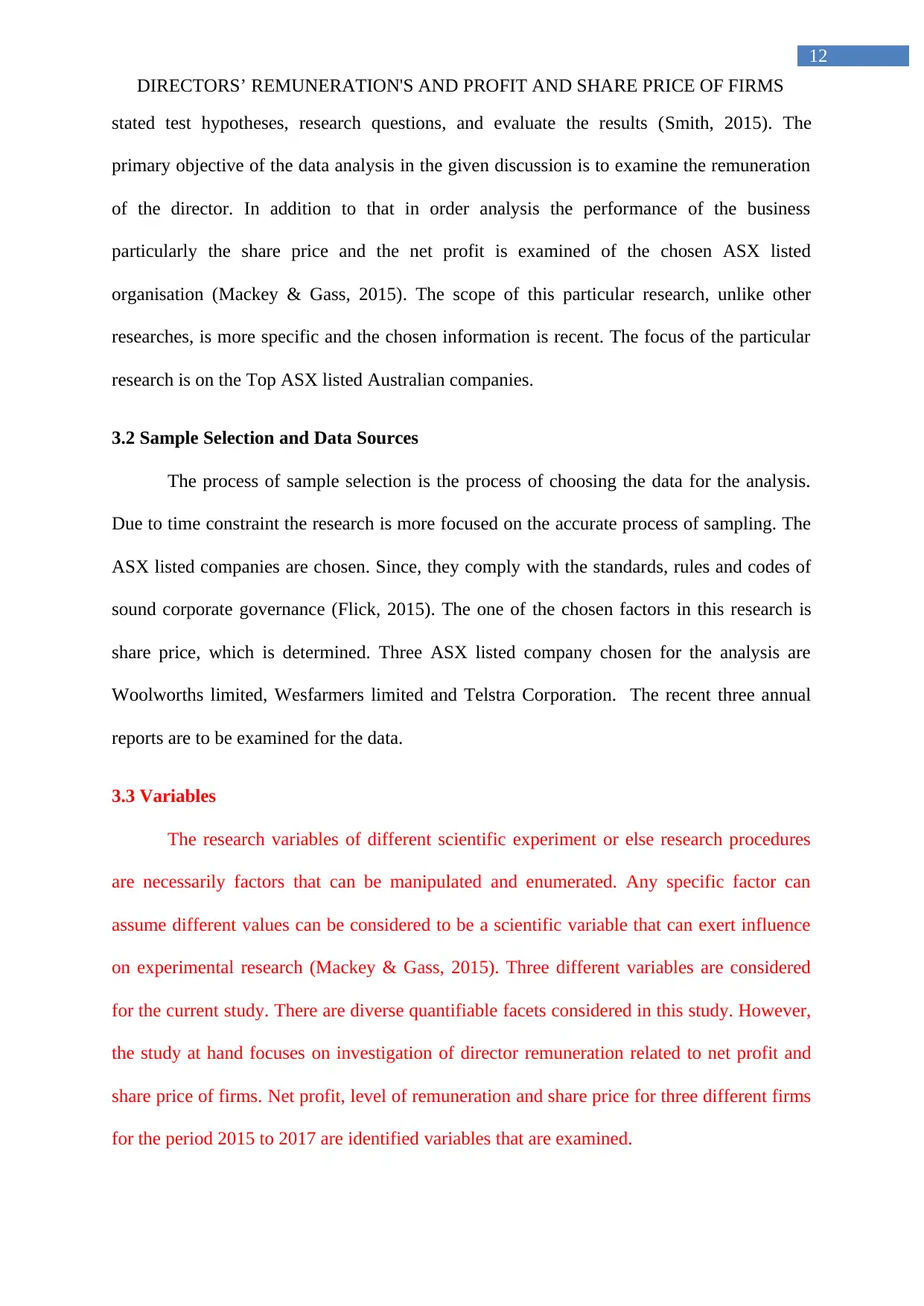
12
DIRECTORS’ REMUNERATION'S AND PROFIT AND SHARE PRICE OF FIRMS
stated test hypotheses, research questions, and evaluate the results (Smith, 2015). The
primary objective of the data analysis in the given discussion is to examine the remuneration
of the director. In addition to that in order analysis the performance of the business
particularly the share price and the net profit is examined of the chosen ASX listed
organisation (Mackey & Gass, 2015). The scope of this particular research, unlike other
researches, is more specific and the chosen information is recent. The focus of the particular
research is on the Top ASX listed Australian companies.
3.2 Sample Selection and Data Sources
The process of sample selection is the process of choosing the data for the analysis.
Due to time constraint the research is more focused on the accurate process of sampling. The
ASX listed companies are chosen. Since, they comply with the standards, rules and codes of
sound corporate governance (Flick, 2015). The one of the chosen factors in this research is
share price, which is determined. Three ASX listed company chosen for the analysis are
Woolworths limited, Wesfarmers limited and Telstra Corporation. The recent three annual
reports are to be examined for the data.
3.3 Variables
The research variables of different scientific experiment or else research procedures
are necessarily factors that can be manipulated and enumerated. Any specific factor can
assume different values can be considered to be a scientific variable that can exert influence
on experimental research (Mackey & Gass, 2015). Three different variables are considered
for the current study. There are diverse quantifiable facets considered in this study. However,
the study at hand focuses on investigation of director remuneration related to net profit and
share price of firms. Net profit, level of remuneration and share price for three different firms
for the period 2015 to 2017 are identified variables that are examined.
DIRECTORS’ REMUNERATION'S AND PROFIT AND SHARE PRICE OF FIRMS
stated test hypotheses, research questions, and evaluate the results (Smith, 2015). The
primary objective of the data analysis in the given discussion is to examine the remuneration
of the director. In addition to that in order analysis the performance of the business
particularly the share price and the net profit is examined of the chosen ASX listed
organisation (Mackey & Gass, 2015). The scope of this particular research, unlike other
researches, is more specific and the chosen information is recent. The focus of the particular
research is on the Top ASX listed Australian companies.
3.2 Sample Selection and Data Sources
The process of sample selection is the process of choosing the data for the analysis.
Due to time constraint the research is more focused on the accurate process of sampling. The
ASX listed companies are chosen. Since, they comply with the standards, rules and codes of
sound corporate governance (Flick, 2015). The one of the chosen factors in this research is
share price, which is determined. Three ASX listed company chosen for the analysis are
Woolworths limited, Wesfarmers limited and Telstra Corporation. The recent three annual
reports are to be examined for the data.
3.3 Variables
The research variables of different scientific experiment or else research procedures
are necessarily factors that can be manipulated and enumerated. Any specific factor can
assume different values can be considered to be a scientific variable that can exert influence
on experimental research (Mackey & Gass, 2015). Three different variables are considered
for the current study. There are diverse quantifiable facets considered in this study. However,
the study at hand focuses on investigation of director remuneration related to net profit and
share price of firms. Net profit, level of remuneration and share price for three different firms
for the period 2015 to 2017 are identified variables that are examined.
⊘ This is a preview!⊘
Do you want full access?
Subscribe today to unlock all pages.

Trusted by 1+ million students worldwide
1 out of 29